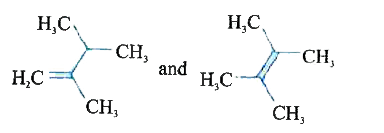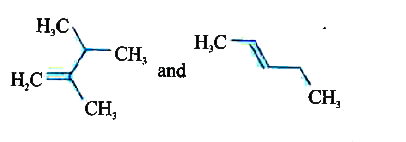An alkyl halide (X)of the folmula C6H13Cl on treatment with potassium tertiary butoxide gives two isomeric alkenes (Y) and (Z)(C6H12). Both the alkenes on hydrogenation give 2,3−dimethyl butane. Perdict the structures of (X),(Y) , and (Z)
The correct Answer is:(x) CH3−CH3∣C∣Cl−CH3∣CH−CH3
(Y) CH2=CH3∣C−CH3∣CH−CH3
(Z) CH3−CH3∣C=C∣CH3−CH3
Step by step video, text & image solution for An alkyl halide (X)of the folmula C_(6)H_(13)Cl on treatment with potassium tertiary butoxide gives two isomeric alkenes (Y) and (Z)(C_(6)H_(12)). Both the alkenes on hydrogenation give 2,3-dimethyl butane. Perdict the structures of (X),(Y) , and (Z) by Chemistry experts to help you in doubts & scoring excellent marks in Class 12 exams.
Topper's Solved these Questions
- BOOK - ALLENCHAPTER - ALKENE, ALKANE & ALKYNE EXERCISE - EXERCISE-2103videos
ALKENE, ALKANE & ALKYNE
- BOOK - ALLENCHAPTER - ALKENE, ALKANE & ALKYNE EXERCISE - EXERCISE-4[A]43videos
ALKENE, ALKANE & ALKYNE
- BOOK - ALLENCHAPTER - ALKENE, ALKANE & ALKYNE EXERCISE - EXERCISE-5(A)28videos
ALKENE, ALKANE & ALKYNE
- BOOK - ALLENCHAPTER - AIIMS 2019EXERCISE - CHEMISTRY35videos
AIIMS 2019
- BOOK - ALLENCHAPTER - ALKYL AND ARYL HALIDEEXERCISE - EXERCISE-05 (B)37videos
ALKYL AND ARYL HALIDE
Similar Questions
An alkyl halide (X)of the folmula C6H13Cl on treatment with potassium tertiary butoxide gives two isomeric alkenes (Y) and (Z)(C6H12). Both the alkenes on hydrogenation give 2,3−dimethyl butane. Perdict the structures of (X),(Y) , and (Z)
View SolutionAn alkyl halide (A) of formula C6H11Cl on treatment with potassium tertiary butoxide gives two isomeric alkenes (B) and (C) C6H10. Both alkene on hydrogenation give methylcyclopentane. Predict the structure of (A), (B) and (C).
View Solution
Knowledge Check
- Question 1 - Select One
An alkyl halide of formula C6CH13Cl on treatment with potassium t-butoxide gives two isomeric alkenes (C6H12). Both alkenes on hydrogenation give 2,2-dimethylbutane. Isomeric alkenes are
ACH2=C∣CH3−C∣CH3H−CH3andCH3−C∣CH2=C∣CH3−CH3BCH2=C∣CH3−C∣CH3H−CH3andCH3−CH=CH−CH2CH3CCH3−CH=CH−CH2CH3and(CH3)2C=(CH3)2DCH2=C∣CH3−C∣CH3H−CH3andCH2=C∣CH3−CH2−CH2−CH3 - Question 2 - Select One
An alkyl halide of formula C6H13CI on treatment with potassium t-butoxide given two isomeric alkanes (C6H12) . Both alkenes on hydrogenation give 2,3 dimethyl butane. Isomeric alkanes are
A B
B C
C D
D
- Question 3 - Select One
An alkyl halide of formula C6H13Br on treatment with potassium t-butoxide gives two isomeric alkenes dimethy butane. Isomeric alkene are :
A B
B C
C D
D
An aromatic kentone (X) has the molecular formula C10H12O2. On vigorous oxidation, it yields a dibasic acid (Y) having the formula C9H8O5 which rapidly forms an anhydride on heating. (X) on strong heating with sodium hypobromite gives monobasic acid (Z) with the formula C9H10O3. (Z), when heated with soda lime, gives 3-methylanisole. Interpret the above reactions and deduce the structures of (X), (Y), and (Z).
View SolutionAn alkyl halide of formula C4H9Cl on treatement with alcoholic potash gives alkenes C4H8. Both alkenes on tratment with HI gives 2-iodo butate. Isomeric alkenes are
View SolutionAn alkyl halide of formula C4H9Cl on treatment with alcoholic potash gives alkenes C4H8. Both alkenes on treatment with HI give 2-iodobutane. Isomeric alkenes are
View SolutionAn alkene (C6H12) is optically active.This on reductive oxonolysis gives
View SolutionNo. of structural isoneric alkenes (molecular formula =C6H12) which all give n-hexane on hydrogenation in presence of metal catalyst
View Solution

